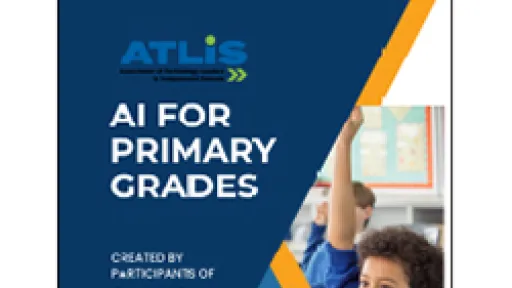The vendor-vetting checklist for tech leaders of independent schools is well established: cybersecurity, interoperability, educational impact, and home connectivity.
It’s time to add community building to the list, according to tech leaders leading their peers through the whys and hows of selecting vendors and products for their alignment with school values, missions, and communities.
“Often, tech leaders in independent schools don’t think they have a role in community building, and they think it’s other people’s work,” said Shandor Simon, director of technology at Beaver Country Day School in Chestnut Hill, Massachusetts.
“I like to remind them there are a lot of places where we are impacting the student experience of what it is like to be at our school, where there’s a sense of belonging and respect for their identity.”
The ATLIS Community-Building Framework for Technology Leaders shows that community building encompasses a broad and interlocking landscape of partnerships, systems, and technology. Through the technology aspect, tech leaders can promote and solidify practices that foster respect, inclusion, and accessibility among students, families, and staff members.
“As we think about the sources and the representation of voices, this is incredibly important because whoever is building these [tech systems], their personal worldview and lens get subtly injected into them,” said ATLIS Senior Director of Education and Content Ashley Cross, Ed.D., CAE.
“When certain voices are left out, that’s also problematic. As ed tech tools evolve, is the student’s representation reflected in the community?”
Being aware of community-building considerations when vetting technology not only can foster a sense of belonging among the student population but also can unlock learning by creating an equitable and technologically optimized educational environment.
As Simon put it, “It shows our commitment to providing students with the tools they need to explore their passions and prepare for the future world.”
Identity and Inclusivity
Tech leaders supporting a school’s community-building efforts isn’t necessarily new, said Simon. Since the COVID-19 pandemic, many tech teams have turned their attention to home connectivity and student access to learning devices. Both fall under the community-building lens, Simon added, because “it’s making sure that everyone has access to what they need and that it’s an even playing field.”
Schools are sometimes required to use legal names in documents such as transcripts, but, Simon said, “should that drive how we refer to the student digitally?” The driving factors should be the student’s preferences, demonstrating care for their personhood and being sensitive to how they’re represented in the system.
“In the classroom, a teacher would never call ‘Alexander’ by his full name if he prefers ‘Alex’ because the teacher knows that’s how the student wants to be identified,” Simon said.
In vendor vetting, technology assessments are still catching up to textbook reviews that have long scrutinized materials for diversity and alignment with school values, said Leanne Rainbow, director of education technology at Taipei American School in Taiwan. Even as schools welcomed students who had a variety of needs and family configurations, student information systems were “historically set up with limitations such as ‘mother’ and ‘father’” as sole choices in family makeup, she said.
“Families need flexibility. For example, a student’s pronouns can change,” Rainbow said. “We need to keep up with and employ software that allows students to be represented accurately as they're exploring their own identities.”
Some vendors are already forging ahead with inclusive software, and “kudos to them,” said Rainbow. Others, she hopes, are spotting the trends and will increasingly incorporate more inclusive elements into their products.
“Just like cost and privacy are always concerns when we’re looking at software, DEI and making sure that software is accessible and reflects our values as a community are other considerations that need to be in the mix.”
Shandor Simon, Beaver Country Day School
In the interim, tech leaders have the power to work with vendors to correct any gaps in the software. When the budget allows, changes are possible.
As the ATLIS Community-Building Framework highlights, an equitable process for vetting vendors and consultants includes advocating for “options to incorporate the school’s community building priorities into software practices.” Tech leaders should assess vendors for potential biases and exclusions while sharing community building-focused feedback and partnering on community building-related improvements.
“As tech leaders, we have leverage over many of our vendors because we’re giving them money for a product,” said Simon.
“We need to tell them if the product isn’t doing what we need. Just like cost and privacy are always concerns when we’re looking at software, community building and making sure that software is accessible and reflects our values as a community are other considerations that need to be in the mix.”
Simon, a member of the ATLIS Community Building Advisory Committee, captured some of these considerations with a list of the following guiding questions for considering new technology:
- Does the app/system respect the identity of students/families/employees?
- Is the app/system accessible to all community members?
- Does the app/system reflect who we are as a school/community?
Further, it helps to start the community-building dialogue early in the process, advised Matt Flora, managing director of consulting firm Ankura. Assess vendors for security and privacy while probing for accessibility and accommodations for students, families, and staff members with varied abilities and languages, he suggested.
“Schools can look at needs across the student base, but they might not be thinking about families,” Flora said.
“In many cases, parents and guardians will be using the products as well, so it’s important to make sure that platforms have modules or adjustments available for vision, hearing, and language.”
As questions become increasingly nuanced and challenging, schools need software equipped with flexibility, said Rainbow. Her school struggles with finding software that allows enough customization to accurately reflect various family structures and respond with ease to changes in student identity. For students exploring gender identity, she said, it would be helpful if software could note preferred gender on some publications and assigned gender on others.
“We want to make sure we are supporting our students,” she said. “They are our primary focus. There is definitely a lot of soul searching for us as an institution, making sure that we do right by as many people as we can. Flexibility in the software is one way that we can do that.”
Rainbow’s school instituted a three-year review process for all technology purchases, regularly scrutinizing software for its ongoing suitability and alignment with school values. It’s almost like the initial rollout, she said, repeated regularly to make sure the software keeps pace with changing times.
Each review explores data privacy, community-building components, and progress toward educational goals, Rainbow said. The system is intentionally manageable, dispensing with unwieldy surveys and replacing them with sit-down conversations. If the vendor can’t or won’t make adjustments to undesirable elements, tech leaders must ask whether the software’s benefits outweigh “such a glaring concern.”
“It has to be part of the continuous cycle, not just when you adopt the software but as you continue to vet it over time,” she said.
“In many cases, parents and guardians will be using the products as well, so it’s important to make sure that platforms have modules or adjustments available for vision, hearing, and language.”
Matt Flora, Ankura
AI Rising
After products incorporating AI suddenly began “popping up like daisies,” said Cross, ATLIS developed guidance to help tech leaders navigate their options. Along with the ATLIS AI Tool Evaluation Questions, the AI Case Studies document encourages tech leaders to reflect on how an AI-enabled tool under consideration could support the school’s educational mission and values.
From a community-building perspective, AI is revolutionizing access to education technology, said Rainbow. Through AI, one toggle can translate a page into any world language, rather than a limited selection. For people with visual impairments, AI can neatly summarize and analyze the key points of a site, instead of forcing users to sit through a word-for-word computer reading.
But with powerful uses come powerful flaws. Research shows that AI systems have not been trained on diverse sources, building inherent bias into the software, said Cross.

From facial recognition software for campus security to classroom-based products that deliver feedback to students, AI can “systematically amplify the subtle biases that have been put in them,” Cross said.
AI “can be a little scary” when it comes to security, privacy, and respect, agrees Flora. A vendor’s use of public AI that can be manipulated could generate faulty output that uses offensive language, he said.
The client’s job is learning upfront the source of the data the AI is using — such as a public chat versus secure AI developed by the vendor — and where and how long the information is stored.
Remember that AI is pulling information from historical sources, generated long before community building and identity were societal considerations, Flora added. “It’s a little dangerous because they’re pulling, literally, from everything on the internet,” he said. “When we talk about inclusion, we’ve made great headway in the last decade. However, AI is pulling from many, many years before that.”
Leading the Way
Vendor vetting requires a team effort across departments and communities. Rainbow’s school has launched a new effort to note all users potentially affected by a software and assigning school staff members to make sure those users have a say in the vetting and review conversations.
Cross suggested being intentional in team-building and leveraging existing relationships to build an effective group of advisers. Choosing advisers is “not always about the title people have,” Cross said. “You have to understand the subtle dynamics. Who is influential in the school?”
Tech leaders who don’t have a seat at the school leadership table can follow the “build your own table” concept, convening interested and affected players to elevate vendor vetting for community-building considerations to a higher strategic level. “There’s a great opportunity there for technology leaders to show up with their leadership perspective,” Cross said.
“A lot of schools either have a community-building director or mission, or it’s embedded in their culture, and this is a way through the technology lens to have conversations about how this technology is received by users, how it’s accessible and inclusive, and how it’s representative of the community.”
Systemizing community building into vendor vetting demands that IT leaders embark on a long voyage toward a destination that is always changing. In this environment, the ATLIS Community Building Framework offers a chart for staying on course. Its three tiers start with “low-hanging fruit” that IT leaders new to the effort can apply to achieve their first successes, said Cross.
“It’s not a checklist, but it gives you a menu of options to work with,” she said. ATLIS is also now tracking demographics among its vendor members to help tech leaders address community building-related sourcing questions. While large vendors will always be necessary for their scope and cost effectiveness, tech leaders can expand their horizons to consider bids from smaller, local vendors with diverse ownership or that support historically marginalized communities.
“It starts with being mindful of having these conversations,” Cross said. Simon agrees that the community-building framework isn’t prescriptive but is adaptable to the unique needs of each school. “You have to understand the values your institution has and make sure the products you bring into it are aligned with those values,” he said.
A tech mindset that incorporates community building “enhances the total student experience,” said Cross. “It’s a holistic thing,” she added. “It’s not just one little sliver, but it’s overall really enhancing the student experience.”




